How to Know When to Change Your Product Packaging
By: phase1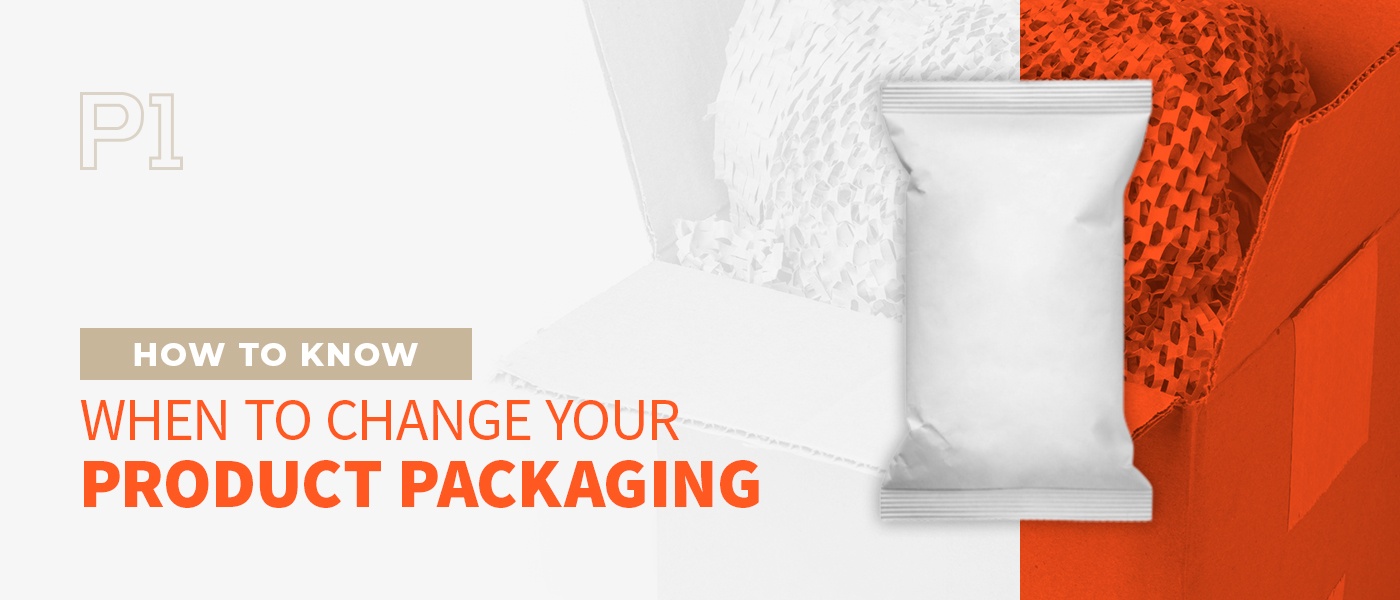
As a product-based company, you understand the importance of package design. A design can make a product fly off the shelves or sit collecting dust. It conveys your brand identity to the world — your goals, values, assets and personality. For better or worse, package design is paramount. Even the best products suffer from flawed packaging conception, while mediocre products thrive with excellent packaging. With an outdated, unclear or boring packaging, your product will never reach its full potential.
Your product is uniquely beneficial. You know it — you merely need to convey it to your consumer. At a glance, consumers need to know why they should choose your product over other, similar ones. Competition is fierce. Retail stores contain floor-to-ceiling shelving and aisles of choices, while online shopping provides endless options. If you want your product to stand out in the sea of competition, you’ll need the right packaging. It might be time to workshop and refresh your current design. Use this guide to help you determine if it’s time for a packing change. Learn when and how to change your product packaging.
Benefits of Updating Your Packaging
Changing your packaging can redefine your brand identity. Packaging influences how consumers perceive your product and business — plus, whether they notice it at all. The simplest design refresh can significantly impact your sales, catching eyes and drawing in new customers. Because it can make such a remarkable difference, it should always be a deliberate undertaking. When you choose to update your packaging, here are some of the benefits you’re likely to experience.
Attracting Attention
A packaging redesign can attract a lot of attention. Think about whose eyes you wish to draw and which design choices will pique their interest. Every detail is crucial. Color can play an influential role in attracting new buyers. For instance, green and earthy tones suggest sustainability and attract buyers who care about the environment. In most cases, men prefer cool tones, while female customers prefer warmer tones. Dark blacks and grays create a feeling of luxury and attract high-end buyers.
With a packaging design change, whether subtle or extreme, you can earn consumers’ attention. The right changes will make your product stand out. Take note of your competition. How can your packaging be unique? With so many options to browse, your audience will notice novel designs. Think about what changes you can make to attract more attention.
Adapting to Trends
Trends come and go. This truism doesn’t merely apply to fashion — it’s also characteristic of product packaging. Fonts, colors, styles, symbols and layouts go in and out of style. Keeping up with current trends can keep your brand relevant. While consumers appreciate thoughtful retro designs, there’s a fine line between vintage and outdated.
If you came up with your designs in line with past trends, it might be time for an update. Adapting to contemporary styles can help your brand compete against newer products. Be sure to keep your target audience in mind. How crucial is trendiness to your audience? For instance, if you’re trying to sell to younger consumers, you’ll need to keep your finger on the pulse of what’s in vogue.
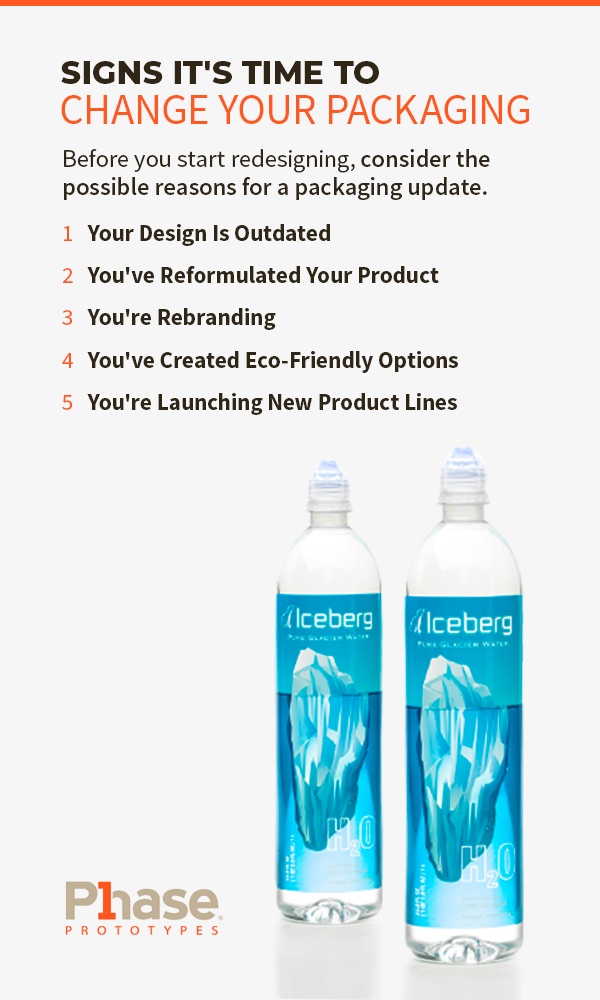
Signs It’s Time to Change Your Packaging
Determining when to change product presentation can be tricky. In some cases, random design changes can annoy consumers or make your products less recognizable. In other cases, an update can skyrocket your sales and enhance your brand image. Before you start redesigning, consider the possible reasons for a packaging update.
Your Design Is Outdated
The most straightforward reason for a change is an outdated design, but it may be challenging to know if your concepts have fallen out of fashion. If you’re unsure, do some investigating. Research design updates in similar products. Stroll store aisles or browse online to get a closer look at your competitors. You could also check out the Pantone Institute’s colors of the year to see which colors are popular at the moment. As a rule of thumb, if you designed your packaging in line with past styles, it might be time for an update.
Tread lightly. Chasing every trend without a guiding strategy might make your brand seem desperate to fit in. Sometimes, differentiating yourself can be positive. Rather than mimicking your competitors, be unique when refreshing your packaging. If you change your design for the sole purpose of matching the latest fad, try to be subtle. Ensure your packaging retains a recognizable identity.
You’ve Reformulated Your Product
Significant alterations to your product, such as new ingredients, signal it’s time for a design change. When you want customers to know about your product improvements, announce them with your packaging. Old messaging and wrapping can even be confusing if sweeping changes have occurred. Any time you’ve reformulated a product, alter your design to represent the change.
You’re Rebranding
Several reasons might compel you to rebrand. Are you selling new products or overhauling your current offerings? Has your industry been the subject of controversy? Have your sales dropped and customers lost interest? Are you looking to target a new consumer base? Regardless of the reason, rebranding requires design change. Determine the new message you wish to achieve. Then, use colors, fonts and imagery to represent that new message.
You’ve Created Eco-Friendly Options
Concern for the environment is rising. About two-thirds of Americans say protecting the environment needs to be one of the government’s top priorities. Offering eco-friendly options can improve your brand’s reputation and image, but only if consumers know about the change. If you’re rolling out eco-friendly products, create new packaging. You can represent this change with the color green and nature-related symbols.
Keep in mind that well-informed consumers look past “greenwashed” packaging. To win those consumers, detail specific changes on your packaging using numbers, figures and trusted labels. For instance, if you’ve earned a Green Seal certification, include the logo on your new packaging. If you use sustainable packaging materials, note this as well. Be sure to update your company’s “about us” page to signify the change. It would also be wise to reach out to the media, so consumers can consult external sources about your brand.
You’re Launching New Product Lines
If you want consumers to notice your new products, you’ll need to upgrade your packaging. Show off your efforts to create new product lines. On existing products, you might add nods to your new offerings. For example, you could add text reading, “Try our new flavors.” You might also want to update your color scheme to differentiate products while maintaining the same general layout.
Tips for Changing Your Packaging
So, you’ve decided it’s time for an update. Now what? It’s crucial to be cautious and mindful when changing your packaging, or you’ll run the risk of losing customers. Many companies have learned this the hard way. For example, in 2009, Tropicana saw a 20% decrease in sales after a redesign. This dramatic instance illustrates the difference packaging can make for sales. On the other hand, successful design changes can increase a product’s popularity exponentially. To ensure your redesign has a positive influence on your sales, follow these tips.
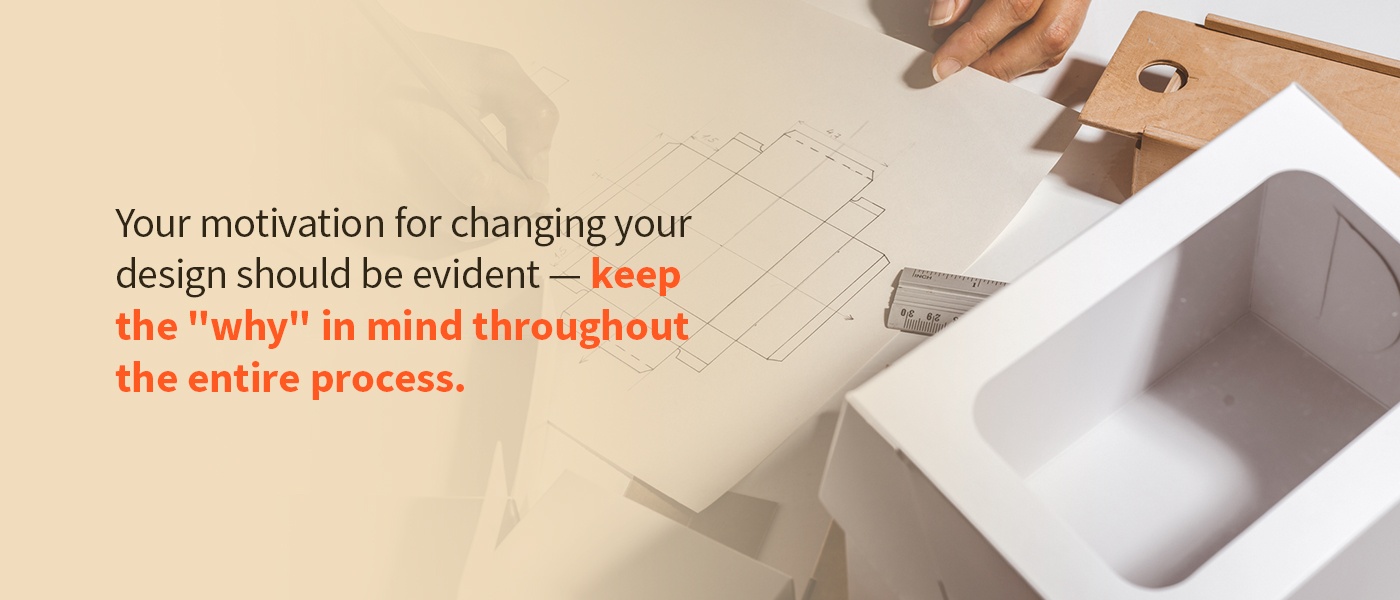
Establish Your Goal
Before you take any other steps, determine your goal. Do you want a complete overhaul, or a subtle upgrade? Know whether you want to start from scratch or subtly alter your existing design. If you have an established customer base, keep them in mind. You’ll want to make sure your new design is still recognizable, as Tropicana learned more than a decade ago. If consumers who favor your brand have trouble finding it, you’re bound to lose their business.
Once you have a grasp on where to start, decide the functions your new design should fulfill. Determine the precise reasons you want to make a change. Are you trying to attract a new target customer or strengthen your connection with the same audience? Are you looking to pull your brand out of the past and into the present? Do you want to draw attention to improvements or changes? Your motivation for changing your design should be evident — keep the “why” in mind throughout the entire process.
Research Your Audience
You’ll need to understand your target audience. Determine their demographics — their gender, age, religion, education level, occupation and socioeconomic status. Then, put yourself in your typical consumer’s shoes. Think about their attitude, lifestyle, morals and interests. What compels them? What interests them? What are their hopes, fears and goals? Brainstorm answers to these questions. Perform some research. The better you get to know your audience, the more you can connect with them.
Create an Appealing Prototype Packaging Design
Draw up a design that will appeal to your target audience and meet your goals. Of course, this is easier to conceptualize than it is to carry out. It’ll take time and effort, trial and error. As you design your new packaging, strive for these goals.
- Be mindful of color psychology and its impact: It’s vital to understand the emotions your color choices might evoke. Be cautious as you choose a color palette.
- Use negative space: A lack of negative space can be overwhelming and confusing. A clean design will highlight your logo, imagery and essential information.
- Use meaningful symbols: The right imagery can evoke compelling emotions. Use representations and illustrations to attract customers. For instance, enlarged images of small food items can prompt a consumer’s appetite.
- Be straightforward and honest: Customers want to understand what your product is at a glance. Use transparent messaging and describe your product in simple terms. Only use words like “organic,” “fair trade” or “natural” if those terms are accurate.
- Stay recognizable: If you already have an established consumer base, ensure your logo and use of color will continue to attract your existing customers.
- Choose a convenient solution: Whether you decide to package your product in a box, bag or resealable stand-up pouch, keep convenience in mind. Think about how your consumer will need to use your goods. If it’s a food item, is it one serving or several? Does it need a closeable seal to keep it from going stale? Is the opening generous enough to reach into?
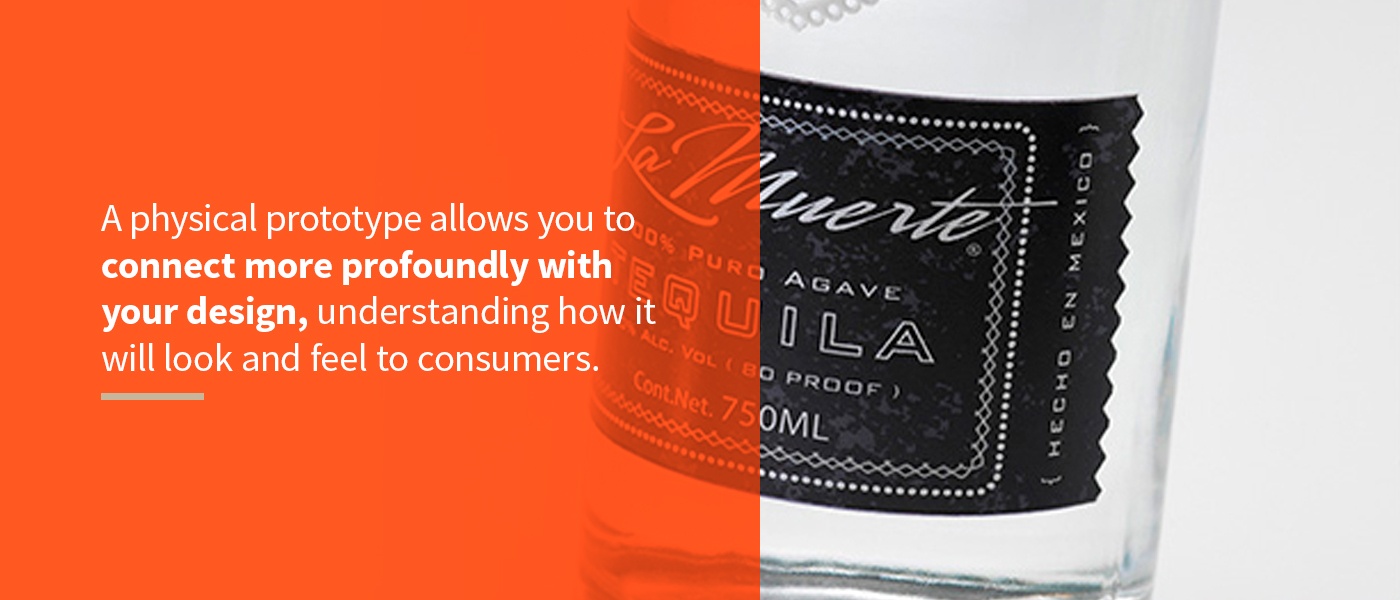
Create a Prototype
Once you’ve established one or more potential designs for your products, you’ll need prototypes for testing. A physical mock up prototype allows you to connect more profoundly with your design, understanding how it will look and feel to consumers. You’ll be able to evaluate the small details, feel the textures and test the packaging with focus groups. Bring your designs to life with prototypes before ordering in bulk — that way, you’ll be able to workshop and perfect your ideas before putting them on the shelves.
Get Feedback
Gather constructive feedback on your prototypes. Ask your team members for input and organize focus groups of your target customers. Allow each member of the focus group to handle the prototype packaging, feeling the texture and looking at it from all sides and angles. Then, ask them some of the following questions:
- How would you describe your initial reaction to this product?
- What did you notice first on the packaging?
- What conclusions would you draw about this product? About the company?
- What information would you look for when buying a product like this?
- What does the packaging remind you of?
- How likely would you be to buy this product?
Once you have answers to these questions, evaluate them. What adjectives did they use? Do those descriptors align with your objectives? Did they seem interested in buying your product? Use the responses to rethink your design choices. You might also try an experiment — place your product among some of its competitors, as it might be on a retail shelf. Ask your target audience to choose a product. Once they make their selection, inquire what drew them to the item they picked, whether it was yours or a competitor’s.
Experiments and focus groups like these will illuminate various factors. You’ll have a stronger sense of your target consumer’s priorities and instincts when shopping. After gathering feedback and conducting experiments, reevaluate your design, adjusting as necessary. Order new prototypes until you feel sure you’ve accomplished your goals. Significant design changes can make or break your branding efforts. Be patient, and try not to rush the process.
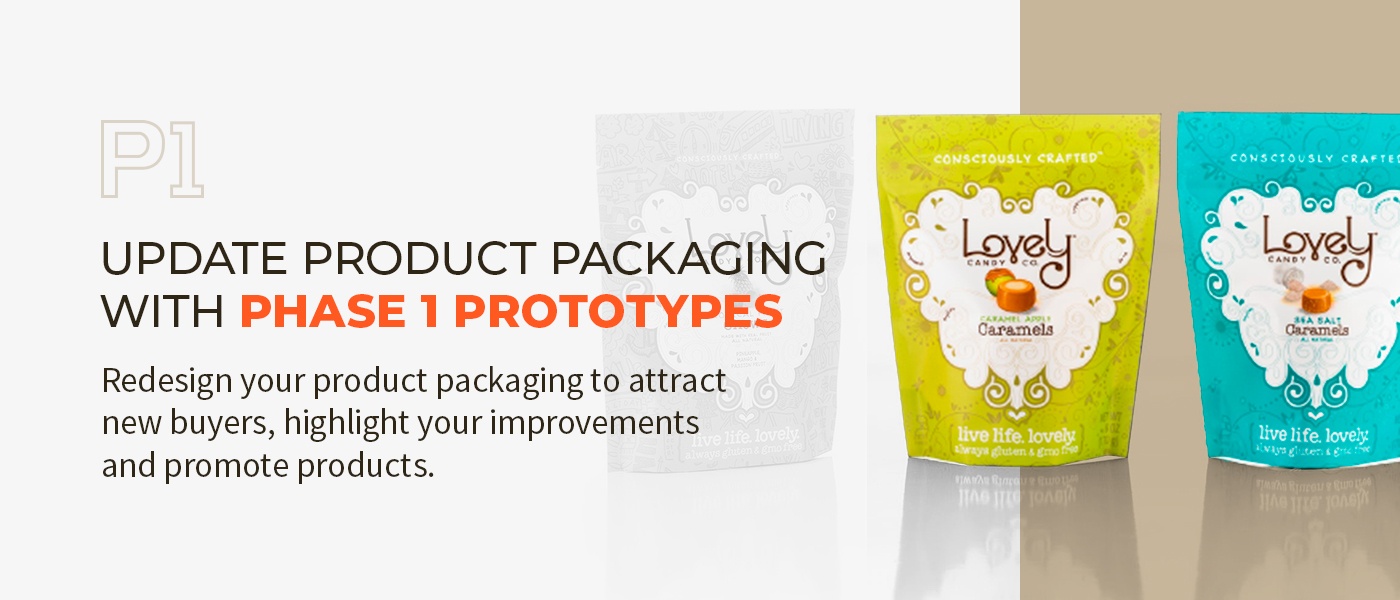
Update Product Packaging With Phase 1 Prototypes
Time and time again, companies have discovered package design’s enduring impact. Successful changes can foster emotional connections, draw attention in competitive spaces and boost sales. On the other hand, ineffective design can lead to negative associations or a lack of recognition. Unchanged packaging may feel stale or outdated — simple refreshes can go a long way. Redesign your product packaging to attract new buyers, highlight your improvements and promote products.
As you redesign your packaging, you’ll need prototypes. A life-sized, tangible prototype allows you to test your design ideas — a vital step in the process. Prototype-driven testing helps you gauge genuine reactions to your designs. At Phase 1 Prototypes, we offer premium packaging options so you can bring your ideas to life. Request your prototype quote today and get a response within 24 hours.
Popular Posts
- 8 Challenges to Overcome in Your Packaging Process
- The 6 Best Tips for Writing Product Packaging Descriptions
- Packaging: The Fifth P of Marketing

Leave a Reply